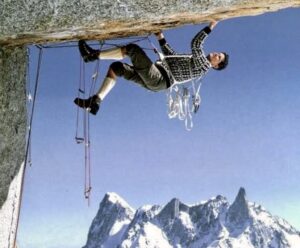Logging and rock climbing are unexpected partners. One involves escaping commercialism through nature, the other profits from one of nature’s commodities. On the Powell River in British Columbia, forestry isresponsible for the discovery of some of the most notorious big wall climbs on the West Coast.
In the near future, views of felled logs and debris will replace those grand vistas of Douglas fir at the top of a climb. Yet to reach the view in the first place requires the roads created by logging companies.
The Powell River region is exceptional for its thick stands of Douglas fir. Taking approximately 50 years to mature, the giant tree grows faster and bigger here than almost anywhere else on earth. Douglas fir are used all around the world for flooring, furniture and cabinetry because of their strength and workability.

Chosen for its accessibility to the Powell River and abundant Douglas fir forests, the Power River Mill has been in operation since 1912.
In 1912, the Power River Mill opened, and it remains the region’s economic backbone, drawing on 403 plots designated for logging Douglas fir. At its peak, the Powell River Mill employed more than 4,000 people and was responsible for one quarter of the world’s newspaper production. Now it functions at just 10 percent of its heyday.
In its infancy, logging was hard labour. Men painstakingly chopped each tree with axes, then hauled each felled trunk by chain to a steam engine for transport. Machinery eventually sped up the process. But the earlier, slower method also allowed new growth to produce.

The Powell River Mill employed more than 4,000 workers in its heyday.
Over time, timber debris has increasingly strewn the region, and valley slopes, once brimming with virgin forests, now bear testament to a battle between machine and nature.
Powell River’s is an industrial city with a population of 13,000. Although not far from Vancouver, it manages to retain its remoteness, thanks to two long fjords that hinder road building. This remoteness eventually drew a small group of climbers, especially the late pioneers Rob Richards and Colin Dionne, to Powell River about 40 years ago.
In 1980, the pair began to notice rock walls staring back at them through the gaps where the giant trees had once stood. Logging roads provided access to this new adventure playground.
Their first attempted big wall climb of 1,000m, 18-pitch West Main Wall in the Eldred Valley took three days. Carrying barely any water or supplies, they slept on the face and succumbed to sweltering July temperatures. They returned in 1993, better prepared, to complete the job in 10 days.

An 18-pitch climb, West Main Wall in the Eldred Valley was first completed in 1993.
In 2007, Dionne began working on a second wall in the Powell River region with his fiancée, Christie Lepitre-Dionne. Sadly, Dionne never completed the climb: A helicopter crash took his life just two weeks after his wedding to Lepitre-Dionne in 2011. Committed to completing the climb her husband started, Lepitre-Dionne continues to frequent the area.

Logging has made climbing walls increasingly visible in the Eldred Valley.
But logging continues to change the once-pristine landscape. Where previously Lepitre-Dionne approached beneath dense canopies of tall West Coast forest, she now moves through rock-lined clearings. The newfound accessibility has opened the area up to a new generation of climbers.

Colin Dionne was killed in a helicopter crash just two weeks after his wedding to Christie Lepitre-Dionne.
Lepitre-Dionne predicts that by 2022, the oldest trees will have succumbed to the chainsaws. Meanwhile, the uneasy waltz between logging and climbing continues.





